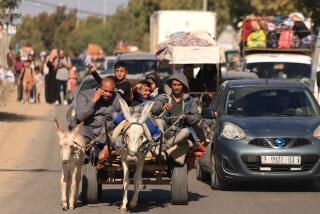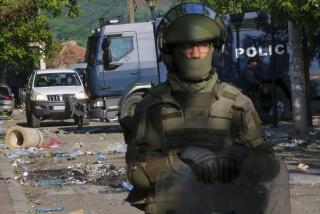U.N. Sends 800 Soldiers to Reinforce Sarajevo : Bosnia: Troops bringing tanks, artillery. Allies issue ultimatum of air strikes, even as Serbs attack 3 ‘safe areas.’
- Share via
SARAJEVO, Bosnia-Herzegovina — In a major move to strengthen its forces in Sarajevo, the United Nations dispatched hundreds of combat troops armed with heavy weapons to the besieged capital Sunday as rebel Serbs launched attacks across Bosnia.
French tanks, British artillery and mechanized infantry were to be posted on strategic Mt. Igman overlooking the city by today. Their deployment followed an escalating barrage of Bosnian Serb attacks on peacekeepers and U.N.-designated “safe areas” in Bosnia-Herzegovina.
The added weaponry will substantially increase the U.N. peacekeepers’ firepower in and around Sarajevo and for the first time will give them the force capable of challenging Bosnian Serb guns trained on this city.
The deployment of about 800 members of the recently created rapid-reaction force appeared to signal a tougher stance by the United Nations, whose mission here has been repeatedly humiliated and paralyzed. And it suggests that a confrontation looms with the Serbs, who will continue to outgun and outman U.N. forces by a wide margin.
In a further show of resolve Sunday, the United States, Britain and France formally notified the Bosnian Serbs of their intent to launch major air strikes and ground action against Serbian targets if the rebel forces attack any of the safe areas.
The warning was delivered by senior generals of the three Western allies during an extraordinary 1 1/2-hour meeting in Belgrade, the Serbian and Yugoslav capital, with the Bosnian Serb army commander, Gen. Ratko Mladic. Officials declined to say how Mladic responded.
The delivery of the allies’ warning, announced simultaneously in Washington, London and Paris, was billed as a follow-up to Friday’s meeting in London, where the allies--with tacit approval from Russia--agreed to launch aggressive military action to protect the safe area of Gorazde.
While the communique issued by the allies Friday had been criticized as vague and almost wavering and did not mention any of the safe areas except Gorazde, Sunday’s warning was precise, specifically mentioning all the so-called havens, including Sarajevo.
In the past, neither ultimatums nor shows of U.N. force have deterred the Bosnian Serbs. Sunday was no different. Defying the West’s warnings, Bosnian Serb forces using tank fire and mortars continued battering the Muslim enclave of Zepa, where numerous casualties were reported, and lobbed shells at Sarajevo, killing six civilians and wounding 35.
The most serious fighting was reported in the northwestern pocket of Bihac, another safe area, which was being punched from all directions by two Serbian armies and a renegade Muslim militia.
Late Saturday, the Serbs fired on a U.N. convoy bringing flour to Sarajevo and on peacekeepers’ barracks, killing two French captains and wounding four other soldiers.
Within hours of that attack, the new European rapid-reaction force was ordered into its first mission. The troops being deployed to Sarajevo boast 500 members of the French Foreign Legion with light tanks, two British artillery batteries with 105-millimeter light guns and an infantry company with 16 cannon-mounted armored fighting vehicles. They will also soon receive 155-millimeter howitzers, French military sources said.
The key change is the range and power of the weaponry, both of which far outdistance that of most weapons the peacekeepers in Sarajevo now have.
“The caliber of the weapons will be bigger, the distances we will be able to strike will be increased, and our firing now will be very precise,” said a senior French military officer. “We will be able to hit targets up to [10 miles] away. We know where every Serb gun position and ammunition dump around Sarajevo is located.”
In addition, the reinforcements, unlike most of the 5,000 peacekeepers now stationed in the capital, are combat-ready.
Still, the Serbs make a formidable opponent and are armed with more than 280 heavy artillery pieces in the hills around Sarajevo.
As for the allied ultimatum issued to Mladic on Sunday, it declared that if Bosnian Serb forces attack Gorazde, the allies will mount “substantial air actions” that “if necessary . . . will be at unprecedented levels.”
“They [the Bosnian Serbs] must realize that necessary action will be taken in response to attacks elsewhere [besides Gorazde], including in other safe areas,” White House Press Secretary Mike McCurry said in Washington.
Defense Secretary William J. Perry said during an impromptu news conference in Washington that much of the allied air armada based in eastern Italy would be ready to go immediately if air strikes were ordered.
U.S. and allied officials have said one of the first targets likely to be hit in any such action would be the Bosnian Serbs’ sophisticated air-defense system, which is made up of about 48 stationary and mobile surface-to-air missile launchers.
Earlier Sunday, Clinton Administration officials had already begun stressing that the North Atlantic Treaty Organization threat of massive bombing attacks applied to all the safe areas.
Replying to questions on CBS-TV’s “Face the Nation,” White House Chief of Staff Leon E. Panetta said, “It is clear right now that the allies are committed to a much more forceful response in terms of the safe areas, particularly Gorazde, particularly Sarajevo, but I think that decision can extend to the other safe areas as well.
“So if I were the Serbs,” Panetta went on, “I would not assume they have room for maneuvering in other areas.”
Although U.N. officials portrayed Sunday’s deployment of the rapid-reaction force as a response to Saturday’s attacks on the convoy and barracks and the killing of the two Frenchmen, the action had been planned for some time, according to diplomatic and military sources.
In addition to protecting peacekeepers, the task force’s principal goal is to improve and secure the winding, unpaved road over Mt. Igman, the only route into Sarajevo and one that is routinely shelled by the Bosnian Serbs.
French Defense Minister Charles Millon said Sunday in Paris that the French and British troops would keep the Mt. Igman road open for the shipment of humanitarian supplies, and he suggested they would reopen Sarajevo’s airport, shut down several months ago.
There are no specific instructions thus far for the rapid-reaction force to protect civilians.
One safe area, Srebrenica, has already been captured by the Serbs, and a second, Zepa, appears ready to fall. More than 30,000 Muslim refugees were expelled from Srebrenica, and many reported widespread murders and rapes.
Times staff writers Art Pine and Stanley Meisler in Washington contributed to this report.
More to Read
Sign up for Essential California
The most important California stories and recommendations in your inbox every morning.
You may occasionally receive promotional content from the Los Angeles Times.














